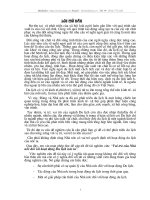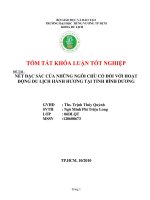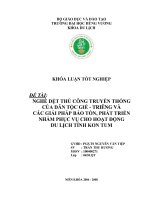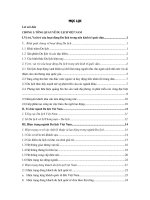Slide giới thiệu hoạt động du lịch
Bạn đang xem bản rút gọn của tài liệu. Xem và tải ngay bản đầy đủ của tài liệu tại đây (1.46 MB, 26 trang )
Inclusive Tourism
Tourism
Tourism provides a wide range of economic opportunities, especially for
developing and least developed countries:
Transport, communications, infrastructure, education, security, health,
immigration, customs, accommodation, agriculture and creative
industries
Inclusive Tourism
Aim?
•to foster linkages and interaction between the different actors in the tourism industry
•to form partnerships with private actors and stimulates the local economy
•to promote the integration of women and the active involvement of local communities
•to emphasise sustainability by taking environmental, social and economic factors into
account
How?
•by integrating poor local communities in tourism value chains through active entrepreneurial
participation
•by ensuring tourism products/services meet international requirements
•by providing market expertise, capacity building, policy advocacy, and formal market
linkages
•by working with existing tourism destinations and supply sectors
The typical visitor journey
A simplified Tourism Value Chain
(ex. Uganda)
United Nations
Steering Committee on Tourism for Development
Delivering as One for Tourism
The SCTD is an innovative approach to Delivering as One: Delivering as One for
Tourism, as a sectoral approach. It is a transformational partnership.
SCTD main objectives:
1. Support Developing countries needs for implementing tourism for development in
an integrated approach, building on the strengths of each UN agency
2. Monitor progress of development through DTIS (Diagnostic of Trade
Integration Study), as well as through new econometric models
3. Mobilize necessary financial resources through existing funding
mechanisms (such as EIF), and work towards the creation of a Multi Donors Trust
Fund for Tourism (for LDCs, and countries -ODA eligible).
4. Mainstream tourism in the global development agenda, as an instrument for
development, poverty reduction and a green growth.
SCTD Tourism Services Portfolio
“Tourism for Development”
Integrated Tourism Development
The SCTD provides specialized tourism assistance aimed to maximize tourism’s
capacity to support countries in reaching their development goals, while preserving
their cultural and environmental assets. The Services Portfolio on Tourism for
Development compiles the services available to LDCs and developing countries.
The Services Portfolio makes available over 50 types of services organized around four pillars:
Areas of intervention
1
BBuilding good governance and sustainability in tourism
2
Promoting investment in the tourism economy
3
Fostering the poverty reduction impact of tourism
4
Encouraging human resources development
Implementing agencies
UNWTO
ITC
UNDP
UNEP
ILO
UNESCO
UNIDO
UNCTAD
WTO
3. Fostering the poverty reduction impact of tourism
Reducing poverty by developing value-chain linkages between the tourism
industry and local producers of goods and services in LDCs
A. Rationale for working on business linkages for poverty reduction
-90% of DTIS linked to tourism state the creation of business linkages as key
challenge.
-Increasing interest by hotel chains, restaurants and tour operators to invest more in
local sourcing.
-Limited capacities and skills of entrepreneurs to meet quality requirements of hotels,
restaurants and tour operators.
B. Objective of joint support
- Maximise the tourism industry’s positive impact on local producers and service
providers & entrepreneurs (e.g. agro-food, creative industries, services).
- LDCs able to take advantage of the complementary institutional and technical
strengths of the different SCTD/UN Agencies (ITC, UNWTO, UNCTAD, UNDP and ILO).
3. Fostering the poverty reduction impact of tourism
Applying an integrated approach to developing sustainable & inclusive
business linkages
A. In-depth feasibility assessment identifying products and services currently sourced
from abroad by the tourism industry that could potentially be met by local supply.
B. Facilitate stakeholder meetings to identify business opportunities for the tourism
industry and how a demand-driven approach can link them with local producers.
C. Enhance supply capacity, consistency and quality characteristics of local products
and services to meet demand requirements of tourism industry and their customers.
D. Cross-cutting: Strengthen support services by trade and tourism support entities
and affected communities through the development of institutional capacities.
ITC Inclusive Tourism Opportunity Study Guidelines
Aim: guideline to carry out a value chain based Inclusive Tourism needs assessment/project formulation
identification of "winner" tourism products and services with market potential
Identification of small producers that produce or could produce the selected products and services
PHASE 1: DIAGNOSIS OF THE CURRENT SITUATION AND CONTEXT
•Step 1- Defining scope and target group(s)
•Step 2- Mapping the Value Chain and its Context
•Step 3- Mapping where the Poor Participate
•Step 4- Conduct fieldwork with Tourists, Enterprises and Support Institutions to gather data and perspectives
•Step 5- Tracking Revenue Flows, Pro-Poor Income and Barriers facing the poor (pro-poor income)
PHASE 2: PROJECT OPPORTUNITIES, PRIORITIZATION AND FEASIBILITY
•Step 6- Identifying where in the Value Chain to seek change
•Step 7- Analysis of strategies
•Step 8- Developing a long list of intervention options
•Step 9- Developing the short list
PHASE 3: DEVELOPMENT OF A WORKPLAN
•Step 10- Developing a project idea
•Step 11- Project programming
FOLLOWED BY:
•Validation roundtable with stakeholder and government to refine and validate project proposal
•Submission of proposal to donors & Implementation
The target audience:
•International and national consultants
•Government
Assessment of Tourism Value Chain & Service providers
Pro-poor income mapping
WsP: woman a significant proportion
WiM: Women in majority
EM: Ethnic minority
Implementation – ITC Inclusive Tourism Training Modules
Linking agriculture to tourism markets
The Module on Agriculture illustrates possible interventions and partnerships
between agro products and the tourism industry.
Aim: To provide farmers and fishermen with the tools they need to assess the
tourism market, and buyers with the skills to develop sustainable partnerships
with local producers.
The target audience:
•Representatives of farmer community institutions
•Potential and existing private sector partners
•Government representatives involved in
the tourism sector or other related industries
•Local support organizations (NGOs)
Linking environmental management and climate change
to tourism markets
The Environment Management and climate change module shows how to
manage tourism developments optimally in terms of the environment.
Aim: To encourage governments, businesses, communities and people to ‘act
locally while thinking globally’. Information on efficient and effective energy use,
reduction in wastes, recycling and re-use and guidelines on environmental
management for eco-hospitality.
The target audience:
•Micro, small and medium-sized enterprises (MSME’s)
•Producer groups, governmental bodies
•Community institutions & NGOs
•Tourism industry (Tour operators, Hotels, Restaurants)
Linking artists to tourism markets
The artistic-cultural training module shows ways to develop local artistic and
cultural services and marketing these through the tourism value chain.
Aim: to develop and market local artistic and cultural services.
The target audience:
•Public sector offices
•Private sector associations
•NGOs supporting the artistic sector
•Artists’ associations/organizations
•Private tourism sector (Hotels, Tour operator)
•Individual artists
Linking handicraft to tourism markets
The Module on Handicraft products indicates ways for artisans on how to adapt
their products to international requirements (quality, trends, design…) and link
their products to tourist markets.
Aim: to increase the artisans’ income and to provide facilitators with the know-how
to develop sustainable business linkages between handicraft producers and the
tourism markets.
The target audience:
•Micro, small and medium-sized enterprises
(MSME’s)
•Producer groups and associations
•Governmental bodies
•NGOs supporting the craft sector
Linking hospitality to tourism markets
The Hospitality Management manual describes how the hospitality and catering
industry operates optimally to fulfil guest expectations and needs.
Aim: To establish an appealing and suitable teaching method for tourist
establishments in developing countries focus on typical gaps and barriers.
The target audience:
•Micro, small and medium-sized enterprises
(MSME’s)
•Community institutions and NGOs
•Tourism industry (Hotels, Restaurants)
Impact Measurement Tool
Tailor-made for the following sectors:
•
•
•
Agro-food products
Creative Industries
Inclusive Tourism
Undertaken at 3 stages of the project:
•
start, prior to project implementation (baseline)
•
half-way to be able to take corrective actions
•
completion of project in order to assess final impact
Survey
A. Social indicators
B. Economic indicators
C. Community development
D. Project-specific information
(agriculture, textile or tourism
sector)
Face to face interviews with beneficiary households
Indicators
Social indicators:
- Housing situation
- Literacy and education
Economic indicators:
- Annual income
- Ownership of assets/livestock
Community development:
indicators:
- Nutrition
- Access to facilities (education, infrastructure,
health services)
-Membership of co-operatives
Product-specific information:
- Materials used and availability
- Environmental impact
Examples of applying the IMT Results of inclusive tourism project in Brazil
Social indicators: Education level – family members
Results: Decrease in illiteracy
Results: Applying the IMT
Economic indicators: Family income level
Results: Increase of households income
Results: Applying the IMT
Tourism indicators: The population’s perception on tourist development’s principal positive
impact
Results: The large majority (73.3%) considers the generation of employment, work and
income as the most important impact
ITC project development & implementation
LATIN AMERICA
AFRICA
ASIA
Brazil
Benin
India (PD)
Bolivia
Gambia (PD)
Lao PDR
Colombia (PD)
Mozambique
Maldives (PD)
El Salvador
Senegal (PD)
Philippines (PD)
Jamaica (PD)
Uganda (PD)
Samoa (PD)
MIDLE EAST
Tonga (PD)
Syria (PD)
Vietnam
PD: Opportunity Study & Project Development
Lessons learnt
• Scaling up: shift from Community-based Tourism to Inclusive Tourism
• Economic sustainability:
• Focus on income generating backward linkages
• Create corporate linkages on local and international level to achieve
win-sin situation (Cruise ship companies, Hotel chains, etc.)
• Tap on existing tourism destinations
• Work only with commercially viable and already existing sectors
• Coordinated assistance by involving several UN agencies (SCTD)
• Use enhanced tourism supply capacity as spring board for exports









